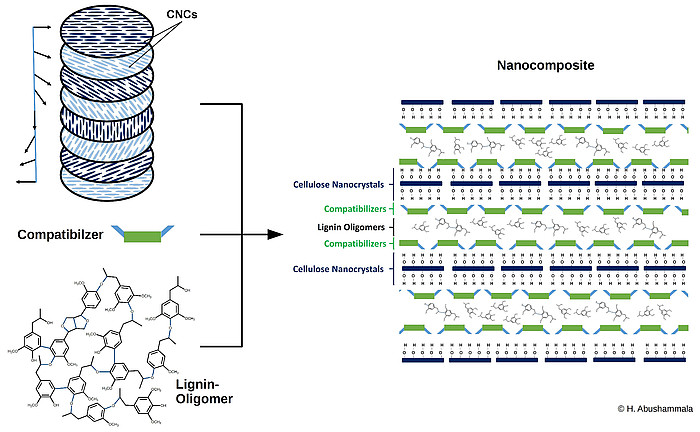LIGNOSIT: Bionic lignocellulose-nanocomposite
In contrast to the sugar components of lignocellulosics, lignin is mostly burnt for energy purposes. Instead, this project proposes to utilize lignin for material applications. As the processing of lignin into solid materials is challenging, Lignosit considers an innovative processing approach by mixing lignin with a liquid crystalline suspension of cellulose nanocrystals, which should serve as processing aid.
The development of organosolv processes for the production of lignin opens new possibilities. With this process, a purest lignin with tunable properties can be obtained. With its lower molecular weight, organosolv lignin is particularly interesting for the development of composites. The CNCs are advantageous as they are able to form liquid crystalline mesophases, which can serve as processing aids. The goal of the project was therefore to develop lignin-based composites, by utilizing CNCs as processing aid and templates for improved processability and performance. To that end the synthesis of a copolymer was also proposed to improve the processability and performance of the composite (Fig 1).
In Lignosit, several steps were successfully achieved that resulted in the successful development of organosolv lignin-based composites. Cellulose nanocrystals were successfully prepared to serve as template for the lignin-based composites. It was demonstrated that the presence of lignin-model compounds did not prevent the formation of liquid crystalline cellulosic mesophases, although the cholesteric pitch was reduced in presence of lignin. This provided hints that it was possible, as proposed, to template organosolv lignin within the CNC mesophases. Also of critical importance for the processing, it was clearly demonstrated that in presence of the lignin-model compound the typical rheological behavior of the CNC suspension was preserved. In particular, an aqueous solution of lignin and CNC exhibited the typical shear-thinning behavior, characteristic of cellulose nanocrystal suspensions. Preserved shear thinning properties are of critical importance for processing. While organosolv lignin alone could not be processed into bulk solid materials, CNCs templating action allowed the preparation of solid materials from lignin. However, the resulting composite materials were initially very fragile. Based on strategies found in the literature, we could improve the properties of the composite by means of crosslinking with an hyperbranched polyester. With a ca 90% lignin content, the so prepared lignin-based composites achieved a Young modulus of 70 MPA and a tensile strength of 3.7 MPA. They also exhibit good flexibility.
| Project title | Bionic Lignocellulose-Nanocomposite with innovative concept of processing for improvement of the physical performance |
| Institution | University of Freiburg, Chair of Forest Biomaterials |
| Research group | Prof. Marie-Pierre Laborie, Dr. Hatem Abushammala, Dr. Jia Mao, Anna Fichtner |
| Project status | completed |

